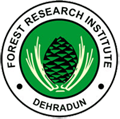
Chandigarh Forest Flora
A Comprehensive Database of Ligneous Plants of Chandigarh (India)
Designed & Developed by Bioinformatics Centre, Forest Research Institute, Dehradun



| Family: Moraceae | Genus: Ficus | Species: Ficus retusa Linn. |
Habit |
Leaf |
Flower |
Fruit |
Bark |
| Synonym | Ficus truncata (Miq.) Miq., Perula retusa (L.) Raf., Urostigma retusum (L.) Gasp, Urostigma truncatum Miq. | Flower Color | White |
| Common Name | Indian Laurel Fig | Flower Type | Hypanthodium |
| English / Trade Name | Indian Laurel Fig | Flowering Period | April-June |
| Vernacular /Local Name | Fruiting Period | July-Sept | |
| Altitude | Up to 1000 m | Fruit Type | Syconium |
| Habit | Tree | Fruit Details | Syconus fruit in pairs, axillary, sub-globose, yellowish when ripe, with 3 broad ovate persistent basal bracts. Achenes ovoid or obovoid. |
| Habitat | Evergreen forests and swamps. | Bark Type | Rugged |
| Distribution | Asia: India | Bark Details | Bright green underneath the corky layer |
| Distribution in chandigarh | Chandigarh Botanical Garden and Nature Park, Sukhna Choe Reserve Forest & Sukhna Lake , Sector 26 | Origin | Native |
| Leaf Type | Simple | ||
| Leaf Arrangement | Alternate (leaves born singly along stem) | ||
| Leaf Shape | Ovate | ||
| Description of Species | Large evergreen umbrageous tree, often epiphytic, forming a tangled mass with aerial roots and horizontal branches. Bark grayish, covered with lenticels bars, bright green underneath the corky layer. Leaves ovate-elliptic or rhomboid, entire, acute or short-acuminate, entire, coriaceous, glabrous. lateral nerves 8- 10 on either half, base 3-nerved, stipules about 0.5 in. long, lanceolate. Male flowers numerous, Perianth segments 3, oblanceolate, spathulate, stamens 1. Gall flowers-perianth segments 3, Female flowers perianth minute, ovary smooth. style short, stigma clavate or cylindric. Receptacle 2-3 in. across, sessile. Syconus fruit in pairs, axillary, sub-globose, yellowish when ripe, with 3 broad ovate persistent basal bracts. Achenes ovoid or obovoid. | Leaf Details | Leaves ovate-elliptic or rhomboid, entire, acute or short-acuminate, entire, coriaceous, glabrous, lateral nerves 8-10 on either half, base 3-nerved, stipules lanceolate. |
All rights reserved by Forest Research Institute, Dehradun